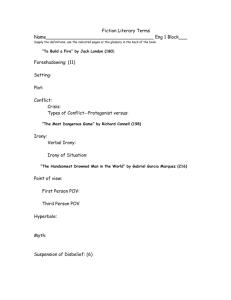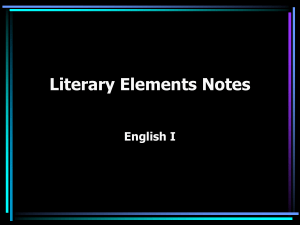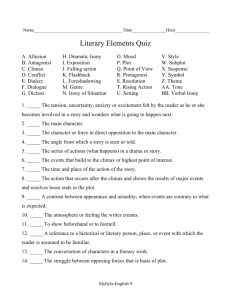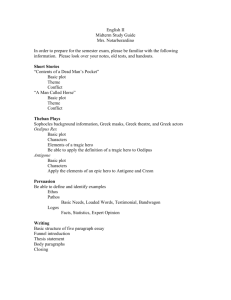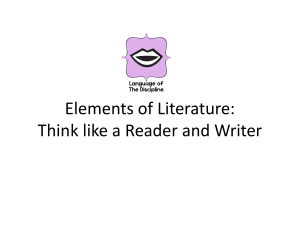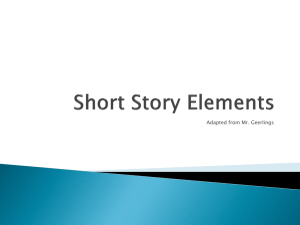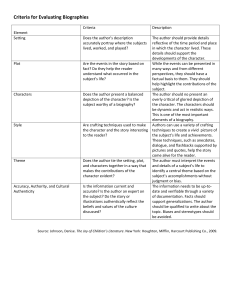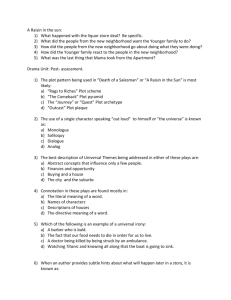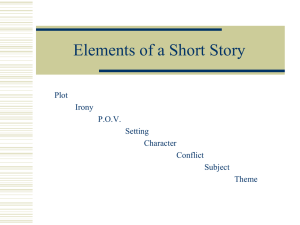Literature Terms List
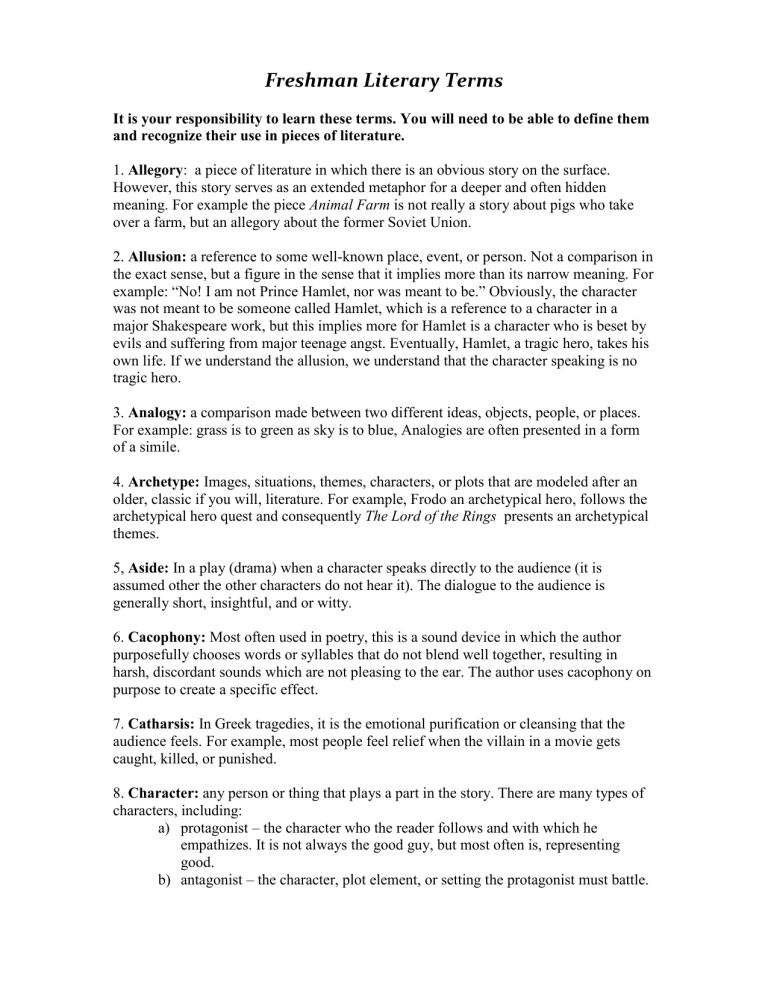
Freshman Literary Terms
It is your responsibility to learn these terms. You will need to be able to define them and recognize their use in pieces of literature.
1. Allegory : a piece of literature in which there is an obvious story on the surface.
However, this story serves as an extended metaphor for a deeper and often hidden meaning. For example the piece Animal Farm is not really a story about pigs who take over a farm, but an allegory about the former Soviet Union.
2. Allusion: a reference to some well-known place, event, or person. Not a comparison in the exact sense, but a figure in the sense that it implies more than its narrow meaning. For example: “No! I am not Prince Hamlet, nor was meant to be.” Obviously, the character was not meant to be someone called Hamlet, which is a reference to a character in a major Shakespeare work, but this implies more for Hamlet is a character who is beset by evils and suffering from major teenage angst. Eventually, Hamlet, a tragic hero, takes his own life. If we understand the allusion, we understand that the character speaking is no tragic hero.
3. Analogy: a comparison made between two different ideas, objects, people, or places.
For example: grass is to green as sky is to blue, Analogies are often presented in a form of a simile.
4. Archetype: Images, situations, themes, characters, or plots that are modeled after an older, classic if you will, literature. For example, Frodo an archetypical hero, follows the archetypical hero quest and consequently The Lord of the Rings presents an archetypical themes.
5, Aside: In a play (drama) when a character speaks directly to the audience (it is assumed other the other characters do not hear it). The dialogue to the audience is generally short, insightful, and or witty.
6. Cacophony: Most often used in poetry, this is a sound device in which the author purposefully chooses words or syllables that do not blend well together, resulting in harsh, discordant sounds which are not pleasing to the ear. The author uses cacophony on purpose to create a specific effect.
7. Catharsis: In Greek tragedies, it is the emotional purification or cleansing that the audience feels. For example, most people feel relief when the villain in a movie gets caught, killed, or punished.
8. Character: any person or thing that plays a part in the story. There are many types of characters, including: a) protagonist – the character who the reader follows and with which he empathizes. It is not always the good guy, but most often is, representing good. b) antagonist – the character, plot element, or setting the protagonist must battle.
c) Static character – a character that does not grow or change in any way. He or she remains the same throughout the piece. d) Dynamic character – a character that does grow or change in the piece. This character often learns a valuable lesson (which may contain a theme of the piece). e) Flat character – a character that only has one dimension. He or she is superficial and does not feel like a real live person. She or he has no depth to their personality. f) Round character – this character feels like a real person. He or she has a lot of depth to their personality. The character may be a good person, but they can still make mistakes. g) Major vs. minor characters - A major character is an important part of the story; a minor character is not. h) Foil – a character (or setting) whose traits are opposite the traits of a main character. By putting to the two together it makes the main character’s traits look larger and more obvious.
9.
Character Analysis : when a reader consciously analyzes (breaks into little pieces) parts of a character to better understand that character and its relationship to the piece as a whole.
10. Dialogue: The words or speeches of a character in a piece. Not narration, which is the words provided by the narrator. Dialogue is always set off by the use of quotation marks.
Hint: when asked to provide a quote from a piece you may quote anything the author wrote; it doesn’t have to be just dialogue.
11. Figurative Language: use of language designed to lead to deeper meaning by offering symbols or figures that represent something more than the literal words.
Figurative language includes: symbols, imagery, metaphors, personification, simile, hyperbole, litotes, synecdoche, allusion, and paradox. It is any time an author uses words that convey a deeper meaning than the literal level.
12. Hyperbole: an exaggeration used for special effect. For example, when your mom says, “I’ve told you a million times to clean your room.” Obviously she has not literally told you a million times, but this exaggeration illustrates the imperative that you should clean your room, and probably immediately..
13. Imagery: use of language designed deliberately to evoke one or more of the five senses. Using imagery, an author allows life to present itself. The reader can hear, see, smell, feel, and touch the experience within his or her imagination. Imagery makes a piece more concrete, that is, more lifelike. For example: “The aroma of the ancient pine smoke of the campfire surrounded me. My eyes teared and my mouth salivated at the thought of slightly burnt, but sweet and sticky marshmallow. The heat from the flickering orange and yellow flames warmed my face, as my backside chilled in the darkening night. Surely a campfire is an experience never forgotton.
14. Irony: a statement whose real meaning is completely opposed to its professed or surface meaning. It is when an event or result is the opposite of what is expected. Isn’t it
ironic, that when a child is teaching a dog to fetch, almost uniformly it is the child who ends up fetching the stick for the dog? There are three specific kinds of irony: a) dramatic irony – when the audience knows something a character does not.
For example, when the audience knows the killer is sneaking up on the protagonist. b) Situational irony – when something happens that is unexpected. See above. c) Verbal irony – when the author says one thing, but means another. It is often a pun or some other play on words. It can also be a name, like naming a Great
Dane Tiny
15. Litotes: The opposite of hyperbole. This is a deliberate understatement to make a point.
16.
Malapropism: the substitution of a wrong word for a correct word. The wrong word often sounds similar to the correct word. The author generally does this in dialogue and the point is to allow the audience or other characters to recognize the low class or intellect of the character making the mistake. For example, having a character say, “He is a variable brat” instead of “He is a veritable brat.” The first sentences means he is a changing brat, while the second means he really is a brat.
17.
metaphor: use of an implied comparison. Comparing two unlike objects or events by saying or implying that one is another. This comparison leads to a deeper understanding of the individual objects or events. For example: My dad is a bear in the morning.
18. Mood: often used interchangeable with tone, the mood is however, focused more on an individual scene than on the whole piece. It is the atmosphere or feeling the author infuses into the scene. Generally, the mood is set by the use of word choice.
19. Paradox: a statement whose surface, obvious meaning seems to be illogical, even absurd, but which makes good sense upon closer examination. For example: Speaking of humanity, Somerset Maugham observed, “the normal is the rarest thing in the world.”
20. Personification: giving human characteristics to an object, animal, or an abstract idea. For example: ”My little horse must think it queer to stop without a farmhouse near.”
21. Plot Analysis: when a reader consciously analyzes (breaks into little pieces) parts of a plot to better understand the plot and its relationship to the piece as a whole.
Specifically, a plot analysis includes exposition, foreshadowing, rising action, climax, falling action, and resolution. In general a plot analysis usually leads to a better understanding of a pieces theme.
22. POV or Point of View: the perspective from which a piece is presented by the author to the reader. There are three different POV’s. a) The most commonly used POV is 3 rd
person omniscient. This is when the story is told from an all-knowing perspective. It is told in past-tense and the author uses third person pronouns (he, she, they, etc.). The author presents the feelings and private thoughts and emotions of any and all of the characters. In
this POV the story is told to the reader from a God like perspective, that is the author knows everything. b) The second most common POV is 1 st person. This is when the author tells the story from a single character’s perspective. The author uses first person pronouns (I or we) and the reader is allowed to know only what that character knows. Nor does the author tell the feelings or through of any other character.
AN easy way to identify this POV is that narrator is the main character. c) The last and least common POV is 3 rd
person limited. Like 3 rd
person omniscient, the author uses past tense verbs and third person pronouns. The difference is the story, like first person, is limited to just one character. The reader knows only what that character knows and only the inner thoughts and feelings of that character.
23. setting: basically, the time and place of a story (or other piece of literature). It also includes the culture and social conditions that effect the main character, the plot, or themes of the piece. Often critical when analyzing literature, a setting is generally very important to theme, plot, and character development.
24. simile: a stated comparison using “as” or “like,” Similes are used to evoke a deeper, figurative meaning. For example: “My love is like a red, red rose.” By Robert Burns
25. Synecdoche: using a part for the whole. For example: fifty winters (years) passed him by. Or using the whole for the part. For example: The halcyon year – meaning summer.
26. Theme: a universal, life lesson, inherent in a piece of literature. The theme is the main point about life that the author is making. Though a piece may have many themes, there is generally an overriding theme that takes precedence, though often themes are debatable.
27.
Tone : the overall feel of the piece that expresses a certain attitude. For example, a tone may be light and humorous, or dark and serious.
28. Tragedy: A genre or type of drama that is meant to raise important questions in the minds of the audience. The questions focus on big ideas like the meaning of life, morality, social relationships, or psychological concepts. According to Aristotle a tragedy must: a) present as the protagonist a tragic hero. This hero will be basically good, of high standing (like a king) but will have a tragic flaw. This flaw will cause the major conflict in the story. Often the flaw is too much pride, called hubris by the Greeks. b) Because of the flaw the hero will ultimately die, however, he will overcome the flaw and will earn the audiences admiration or at least pity. c) The audience will experience some kind of catharsis.
29. Oxymoron: Rhetorical figure by which contradictory terms are conjoined so as to give point to the statement or expression; the word itself is an illustration
30. Symbol : an object, person, idea, etc, used in a literary work, film, etc, to stand for or suggest something else with which it is associated either explicitly or in some more subtle way.
21. Continued:
Exposition:
Narrative hook:
Rising action:
Climax:
Falling action:
Resolution (denouement):
